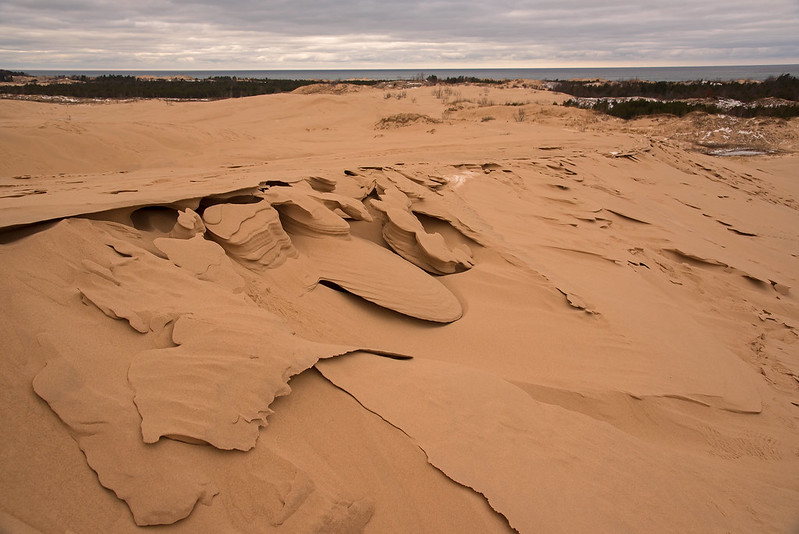
Deep in rural Warren County, Indiana, lies a hidden gorge with a remarkable sandstone canyon riddled with potholes. This part of the stream is actually called The Potholes, and it lives up to its name. Over thousands of years, flowing water and loose boulders carved the soft sandstone creek bed into round pockets or potholes. Boulders caught in the current of the water moved in small circles when trapped in a depression. This action caused the depression to get larger and larger into the current creek bed.
The water in most parts of the creek is about six inches deep, however, dozens of potholes hold two or three feet of water. Walking around this creek is difficult, as you may need to step into a three foot deep pothole to get around. Plenty of rain caused the creek to rise, and we tried to keep dry from the knees up, so it was impossible for us to walk the length of the canyon, and had to double back once from the downstream side, and again from upstream.
The walk through the creek was a bit difficult due to the narrow ledges between deep potholes. If one does not watch, a slip into a pothole may cause a fall or injury, but overall, if you expect a challenging walk, and watch, the walk is great fun.

Colors, shadows, and reflections play off one-another, creating what is described as one of the most beautiful places to visit in western Indiana. It does not disappoint.
On our way out, we ran into three local teenagers in swimsuits, heading down to the potholes. That is truly the way to experience the potholes - each one is round and smooth, about two to three feet wide and deep - built like small, individual whirlpool baths!

If you're lucky enough to find your way to this hidden gem, you'll find a parking area large enough for three or four cars, that's it. The Nature Conservancy describes the gorge as, "loved to death" over the past few years, so a small parking lot may help insure a low number of visitors.
 Following our hike in Matthiessen State Park, we headed over to nearby Starved Rock State Park. This park has many more canyons and trails, so the possibility of seeing frozen waterfalls is very good. The first stop was St. Louis Canyon, one of the more popular areas in the park, and one I tend to avoid when visiting - no real reason, maybe it's just too easy to access. The cold weather had already turned the waterfall into a complete icefall. We explored the falls from a distance first, then made our way around and under.
Following our hike in Matthiessen State Park, we headed over to nearby Starved Rock State Park. This park has many more canyons and trails, so the possibility of seeing frozen waterfalls is very good. The first stop was St. Louis Canyon, one of the more popular areas in the park, and one I tend to avoid when visiting - no real reason, maybe it's just too easy to access. The cold weather had already turned the waterfall into a complete icefall. We explored the falls from a distance first, then made our way around and under.  A lot of times when I visit the frozen waterfalls, it's difficult or impossible to access the area behind the icefalls. It's either too slippery, or blocked by too much ice. Visiting early in the season, I was able to get behind the ice for a completely different view. Careful of falling ice, I explored the 40 foot tall ice column from beneath. The dripping water splashed onto me a bit, and in the single digit temperatures, froze on my camera immediately.
A lot of times when I visit the frozen waterfalls, it's difficult or impossible to access the area behind the icefalls. It's either too slippery, or blocked by too much ice. Visiting early in the season, I was able to get behind the ice for a completely different view. Careful of falling ice, I explored the 40 foot tall ice column from beneath. The dripping water splashed onto me a bit, and in the single digit temperatures, froze on my camera immediately.  Ice cleats are a must when visiting Starved Rock or Matthiessen State Parks in winter. Even when most of the snow has melted, the trails are often packed with ice from thousands of visitors, and most of the canyons are shaded most of the day. The trails are probably the last things to melt, and can be extremely dangerous in winter. Not only can a person slip and fall down, but that fall can result in a drop into a canyon on some narrow trails. The cleats allow you to walk on solid ice and packed snow without slipping at all.
Ice cleats are a must when visiting Starved Rock or Matthiessen State Parks in winter. Even when most of the snow has melted, the trails are often packed with ice from thousands of visitors, and most of the canyons are shaded most of the day. The trails are probably the last things to melt, and can be extremely dangerous in winter. Not only can a person slip and fall down, but that fall can result in a drop into a canyon on some narrow trails. The cleats allow you to walk on solid ice and packed snow without slipping at all. 

















































